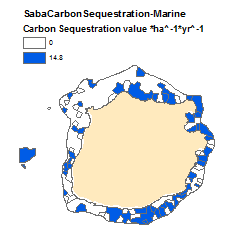The ecosystems of the island of Bonaire support a range of activities that depend on the quality of the natural environment. Tourism is one of these activities and it represents an important source of income for the local economy. Tourism in Bonaire can be divided in stay-over tourism and cruise tourism. Whether further development of cruise tourism is desirable for Bonaire is constantly under discussion. It is thought that more cruise tourists will contribute to economic growth. But, at the same time, there is a fear that an increase in the number of cruise tourists and the investments in infrastructure and other facilities to facilitate this growth will put extra pressure on the ecosystems. And these are the same ecosystems that are vital in attracting not only cruise tourists, but also stay-over tourists.
This study aims at providing quantitative and qualitative information on the potential benefits and negative effects of an expansion of the cruise tourism industry on Bonaire. For this purpose, a socio-economic valuation was first conducted to understand the cruise tourism industry in Bonaire. This resulted in insights that include tourist’s expenditures, the different actors on the island that benefit from these expenditures, the dependency of certain sectors on tourism related revenues and the attitude of tourists towards certain social and environmental changes in the island. This information is derived from tourist surveys, a business survey and literature review.
Second, with the information gathered, and making use of an economic Input-Output model for Bonaire that is linked to an ecologic model, three different cruise tourism growth scenarios were analysed: a baseline scenario, a moderate growth scenario and a rapid growth scenario. This analysis resulted in the calculation of economic benefits that would result from an increase in the number of cruise tourists in each scenario. At the same time, using the ecologic module that is linked to the economic Input-Output model, the socio-environmental impact on a number of natural indicators was also assessed. Certain environmental effects of cruise tourism, like waste production, water consumption and the ecologic footprint of cruise ships, could not be included in the ecologic module and were, therefore, assessed separately from the model.
The surveys conducted amongst tourists have shown the importance of maintaining a healthy reef and the tranquillity on the island. Especially stay-over tourists indicated that they are not willing to return to a more crowded island or an island with a degraded coral reef. Both the survey and the scenario analysis indicate that sectors that benefit the most from the growth of the cruise industry are the transport, restaurant, ‘other services’ (which include tour operators) and trade sectors.
The scenario analysis further indicates that an increase in cruise tourism will generate a growth in GDP within the period of the analysis (until 2024). While the economy grows as a whole, more jobs will be generated. However, given the seasonal character of cruise tourism and the sectors that benefit the most from it, most of the jobs created appear to be in lower income categories. As a result of potential population growth to fill in these new jobs, household consumption and GDP per capita do not increase as much as the GDP growth might suggest. Household consumption at the end of the analysis period (2024) is only $234 higher in the rapid growth scenario compared to the baseline scenario.
The economic growth caused by cruise tourism expansion also results in socio-environmental impacts, as higher number of visitors will increase direct pressures on the ecosystems that are visited. The main impacts that have been analysed are change in land use, decrease in coral cover, water consumption and waste generation and the potential decrease of stay-over tourists as a result of coral reef degradation and more built-up land.
However, not all potential socio-environmental impacts could be included in the scenario analysis. If cruise tourism industry is to expand even further, Bonaire must expand its infrastructure. This means that investments need to be made to accommodate larger amounts of tourists. The scenario analysis does not take into account the impact of these potential infrastructure projects like additional port infrastructure, proper waste management system, water management, more roads and more ground transportation. It was also not possible to assess the effects on the environment and the return rate of stay-over tourists caused by crowding in specific areas and on peak moments.
The results of the study demonstrate that there are external effects related to the expansion of cruise tourism. For example, a decrease in stay-over tourists as a result of rapid growth of the cruise tourism industry may have significant implications for the hotel industry. To make decisions regarding cruise tourism expansion, such external effects should be taken into account. Furthermore, investing on an environmental friendly expansion and the enforcement of environmental regulations will also be of high importance to avoid endangering the ecosystems and, thereby, the tourism industry as a whole. More research on the local impacts of cruise tourism and the effects on the stay-over sector are necessary to draw conclusions on the desirability of the expansion of cruise tourism for the island.


